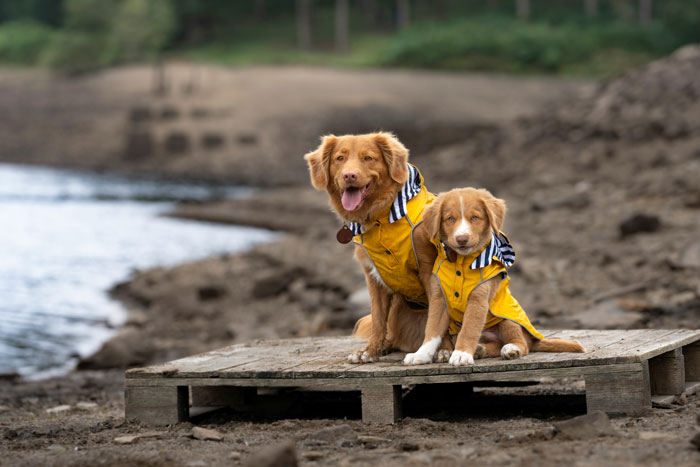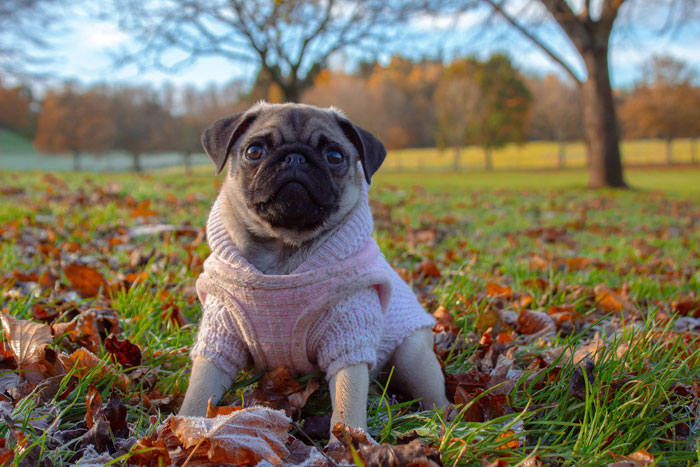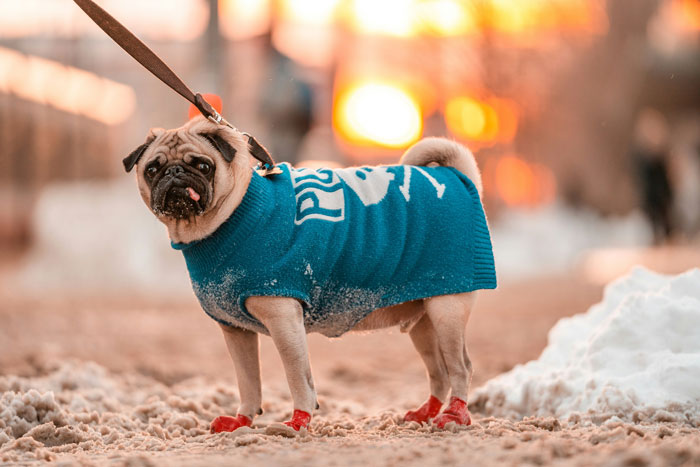Imagine stepping outside on a crisp winter day and noticing your dog shivering or showing signs of discomfort. While certain breeds are naturally equipped for colder temperatures, others may need additional protection from the elements.
This article will discuss the factors contributing to a dog’s need for a winter coat. We’ll guide you on selecting the appropriate coat and ensuring safe wear. Our goal is to help pet parents determine the best way to keep their dogs comfortable during those chilly winter outings.
- Breeds like Huskies and Malamutes often don't need coats thanks to their thick fur.
- Below 32°F, most dogs, especially small or short-haired, benefit from a coat.
- A coat should fit snugly yet allow room for movement.
The information provided herein is for informational purposes only. Please refer to our disclaimer for more details..
Factors Influencing a Dog’s Need for a Winter Coat
Not all dogs are created equal when it comes to the cold. Here’s what impacts your dog’s need to wear a winter coat.
Breed: Built-in Insulation
Dog breeds like Siberian Huskies, Samoyeds, Bernese Mountain Dogs, and Alaskan Malamutes have a double coat. This means a thick, wooly undercoat for warmth and a longer outer coat to repel moisture. It’s like their own furry winter jacket! These are the best dogs with thick coats for cold weather.
Short-haired breeds like Dobermans, Boxers, or Italian Greyhounds lack that protective undercoat. Their fur acts more like a t-shirt than a parka, leaving them more vulnerable to the chill.
Size: It’s All About Surface Area
Imagine a tiny cup of tea compared to a big pot. The smaller cup cools faster because it has more surface area relative to its volume. Small dogs have the same issue – they have lots of skin exposed to the cold in relation to their body size.
Dogs with lean bodies and short coats, such as Greyhounds, Basset Hounds, and Whippets, should also be kept safe from the cold weather.
Large dogs have a lower surface-area-to-volume ratio, helping them retain body heat more effectively.
Age: The Young and the Senior
Puppies: Their little bodies are still developing the ability to regulate temperature. Just like human babies need extra layers, puppies sometimes need help staying warm.
Senior Dogs: As dogs age, their metabolism can slow down, and their coats might thin. Plus, older dogs often develop conditions like arthritis, which gets aggravated by cold weather.
Health Conditions: When the Cold Goes Deeper
Arthritis: Think of how your own joints might feel stiff on a cold day – it’s the same for dogs! Freezing temperatures can make arthritis pain worse, so extra warmth is key.
Hypothyroidism: This condition means a dog’s thyroid doesn’t produce enough hormones, affecting their ability to regulate temperature. They often feel colder in general.
Other Conditions: Any condition that affects circulation, body fat levels, or overall health can make a dog more sensitive to cold temperatures.
Even if your dog falls into one of these categories, it doesn’t automatically mean they need coats. It’s always best to observe how they handle the cold. We’ll discuss signs to watch for in the next section!
Determining When Your Dog Needs a Coat
Look beyond the thermometer! Your dog’s behavior and these temperature guidelines will tell you when it’s coat time.
Temperature Guidelines
While there’s no single magic number, here’s a general guideline to get you started:
- 45°F (7°C) or above: Most healthy dogs can likely handle this temperature range without a coat.
- 45°F to 32°F (7°C to 0°C): Smaller breeds, short-haired dogs, and those sensitive to cold may benefit from a coat.
- Below 32°F (0°C): This is where coats become important for most dogs, especially if they’ll be outside for extended periods.
These are just guidelines! You need to pay attention to your dog’s individual needs. Winter dogs like tough Siberian Huskies have thick fur coats and might be fine without a coat even in slightly lower temperatures. While a sensitive Chihuahua might need one well before it hits freezing.
Behavioral Signs
Your dog is the best expert on how they feel. Look out for these signs that they’re getting too cold:
- Shivering: The most obvious sign! If they’re visibly shaking, it’s time to warm them up.
- Whining or Barking: They might be trying to tell you they’re uncomfortable.
- Reluctance to Walk: If they’re suddenly stopping or trying to turn back, they’re likely not enjoying the cold.
- Seeking Warmth: If your dog is trying to burrow into your legs or head for the nearest sunny spot, they’re telling you they need some help warming up.
Choosing the Right Dog Coat for Winter
Find the perfect fit and materials to keep your pup cozy, safe, and stylish on winter walks.
Fit: Comfort is Key
Snug but not Tight: The coat for your dog should be snug enough to stay in place but not restrict movement. You should be able to comfortably fit two fingers between the coat and your dog’s body.
Measuring Matters: To get the right fit, you’ll need these measurements:
- Neck Girth: Measure around the base of their neck.
- Chest Girth: Measure around the widest part of their chest.
- Back Length: Measure from the base of their neck to the base of their tail.
Material: Choosing the Right Warmth
Choose a material based on your climate and dog’s needs:
- Fleece: A classic choice for chilly, dry days. It’s soft, cozy, and comes in many fun colors!
- Wool: A natural option that’s warm and breathable. Great for moderate cold.
- Waterproof: Ideal for wet, snowy weather. Look for waterproof outer layers with a warm lining.
Features: Function and Fashion
Consider these handy features for added safety and convenience:
- Reflective Strips: A must-have for those early morning or late evening walks!
- Harness Openings: Ensure the dog jacket or coat has a convenient opening if your dog wears a harness.
- Belly Coverage: Provides extra warmth for low-riding pups.
Tip: Many reputable pet stores have staff who can assist you in measuring your dog and choosing the right dog coat or sweater. Feel free to ask for help!
Safety Tips for Using Winter Coats
Coats are great, but they need supervision! Keep your dog warm and safe with these tips.
- Supervision is Key: While a coat keeps your dog warm outside, it’s best not to leave them unattended while wearing it. They could get the coat snagged on something or decide to chew on it.
- Indoor Off, Outdoor On: Dogs can overheat easily, so remember to take the coat off when you’re back indoors. Think of it like your own winter jacket – you wouldn’t wear it inside all day!
- Regular Skin Checks: Even a properly fitted coat can sometimes cause a little rubbing or irritation. Check under the coat regularly for any redness, chafing, or discomfort, especially when your dog first wears it.
Start by letting your dog wear their new coat for short periods around the house. This will help them get used to the feel and ensure it fits well. Gradually increase the time as they become more comfortable.
Alternatives to Winter Coats
Not a fan of coats? There are other winter gear to keep your dog warm during winter.
- Shorter Walks: On those super frosty days, it’s okay to keep those walks a bit shorter. Your dog will still get some exercise, and they won’t get too cold.
- Staying Active Indoors: For tiny dogs or those who dislike the idea of a coat, indoor fun can be the way to go! Play fetch, work on some new tricks, or have a gentle game of tug-of-war.
- Protect those Paws: Don’t forget about those little toe beans! Ice, snow, and road salt can be rough on paws. Consider dog boots or paw wax for extra winter protection.
Conclusion: Do Dogs Need A Winter Coat?
Whether your dog needs a winter coat depends on a few things: their breed, size, age, health, and how well they tolerate the cold. The most important thing for dog owners is to pay attention to their furry friends! They’ll let you know if they’re comfortable or need a little extra help staying warm.
With a bit of careful observation and perhaps a stylish winter coat, you and your dog can enjoy those outdoor adventures all year round, no matter the temperature!
2Kviews
Share on Facebook
 Dark Mode
Dark Mode 

 No fees, cancel anytime
No fees, cancel anytime 




 Image credits:
Image credits:  Image credits:
Image credits:  Image credits:
Image credits: 










































0
1